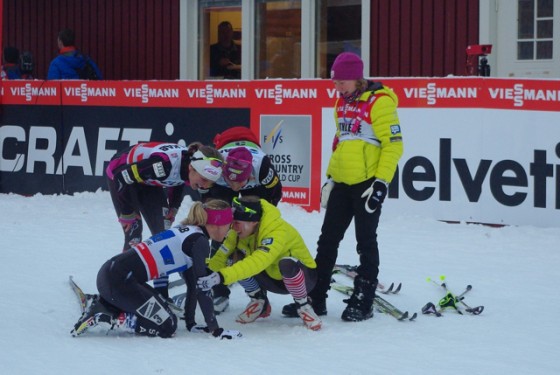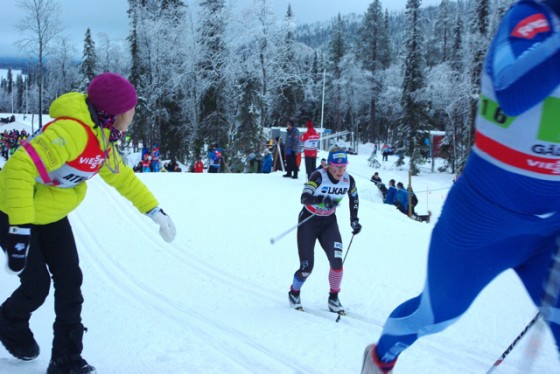
GÄLLIVARE, Sweden – It’s always good to finish a race and be happy with the result. But the icing on the cake is when the entire sport seems to be behind your performance.
And for the U.S. women after Sunday’s historic third-place relay finish, that was the case. As one team after another crossed the line behind them, they were hugged and congratulated – even by teams who surely wished the podium spot could be theirs. The support continued after the race, when other racers, coaches, and commentators took to the internet to congratulate the Americans.
“Congratulations USA!” Swedish World Cup winner Hanna Falk tweeted. “Fun to see and your happy faces inspire!! Aaaawesome;-)”
That was just one of the many messages directed towards the American women after the podium ceremony.
“I think they know how hard we’ve been working on this, and building it up step by step, so I think they can all appreciate what it has taken to get here,” Kikkan Randall told FasterSkier. “They can all celebrate because they know what it’s like.”
Jessie Diggins, who turned in an anchor-leg performance that probably made specatators’ lungs burn and legs ache just by watching it, agreed.
“All of them know what it was like their first time on the podium, so I think they can see that feeling in someone else and go, yeah, I know that they’re on cloud nine right now,” she told FasterSkier.
The work that Randall was talking about doesn’t just come as hours of running and rollerskiing during the summer back home in the U.S. – although there is that.
“It certainly makes the environment of training a lot stronger when you have a team built around you so that you can push each other appropriately, day in and day out,” U.S. Ski Team Development Coach Bryan Fish told FasterSkier as he waited for the men’s relay field to come through on one of their laps. “They’re training really hard. It was awesome to see it pay off.”
But it has also been the years and years of traveling over to Europe for the World Cup, in many cases to get trounced handily by the rest of the field. Mentally, it’s not so exciting to show up for your first World Cup and finish in the 60’s or 70’s. But in the past several seasons, the U.S. women, growing in number, have gotten more comfortable on the circuit. As Randall said in a press conference after the 10 k individual race, it’s lonely to be the only woman, but with a full team, she has more fun and everybody races better.
The five women in Europe right now all spent last season on the World Cup, which also means that they are becoming part of the community.
“We’ve been on the World Cup for a few years now and we know people, we have friends,” Liz Stephen said, before adding that competitors clearly recognize that diversity is good for their sport. “I think it’s fun to see some new faces on the podium. And we feel that way too, even when it’s not us, it’s like, oh, cool, the Slovenians got on the podium today. I think – it makes it really fun.”
The women had discussed on Saturday, too, that Sweden now felt more like home to them, since they have forged a friendship with the women’s team and even flew over for a training camp this summer. There were plenty of cheers from the spectators, with one caveat.
“I feel like the cheers got louder once Charlotte [Kalla] passed me,” Diggins laughed. “They were like, okay, now we can really cheer.”
In fact, all of the women said that support from both the fans and their teammates was what got them through the race.
“The coaches and boys and Ida were out there cheering,” Diggins said. “Ida’s voice was, man, that gave us seconds.”
The fact that the U.S. is even in a position to have an extra woman on hand, more than a full relay squad, is notable – and has only happened in the past few years (it’s also impressive that there’s plenty of strong women back in the U.S still, including Sadie Bjornsen, who teamed up with Randall for a team sprint podium last season). Sargent, who placed 53rd in the 10 k skate on Saturday and is looking forward to sprint races, spent her time on Sunday running around to different parts of the course and cheering at the top of her lungs.
“I’ve known Ida a long time and she gets her cheer on sometimes, but never like today,” said Stephen, who grew up in northern Vermont like Sargent; the two attended Burke Mountain Academy together. “I literally was not sure it was actually her! I have never seen her cheer that way.”
With such a strong team and a little extra confidence now, the Americans are planning to continue their ascent. It’s not over, not by a long shot.
“It’s all part of our strategy,” Randall deadpanned. “We wanted to show that we could put a good relay together, but we didn’t want to let the cat completely out of the bag. I think we all have a little bit of room to improve from today, so that bodes really well for our big goal of the season, which is World Championships.”
Still, it was Diggins’ mental conquest of physical pain as she sprinted past Norway’s Marthe Kristoffersen that will likely be what most people remember. Even World Champions were impressed.
“But man, I just want to say, I was so moved by the way that Jessie skied that last leg for the Americans,” Canada’s Devon Kershaw said while answering questions about his own strong relay performance on Sunday. “To see them medal like that, I was crying a little bit watching it, in the FIS family tent! It was the gutsiest race I’ve ever seen, and what a weekend for the American women. “
Chelsea Little
Chelsea Little is FasterSkier's Editor-At-Large. A former racer at Ford Sayre, Dartmouth College and the Craftsbury Green Racing Project, she is a PhD candidate in aquatic ecology in the @Altermatt_lab at Eawag, the Swiss Federal Institute of Aquatic Science and Technology in Zurich, Switzerland. You can follow her on twitter @ChelskiLittle.




